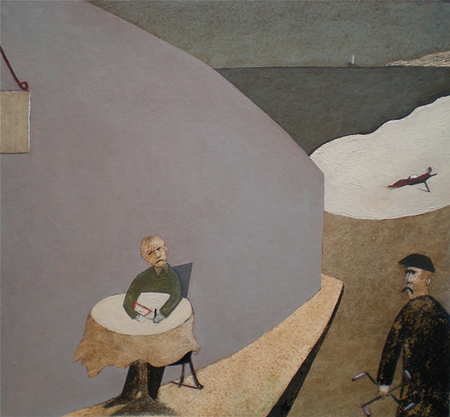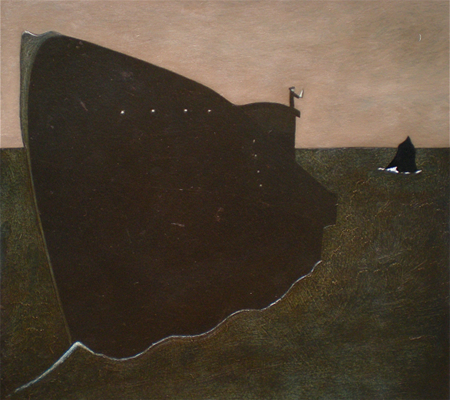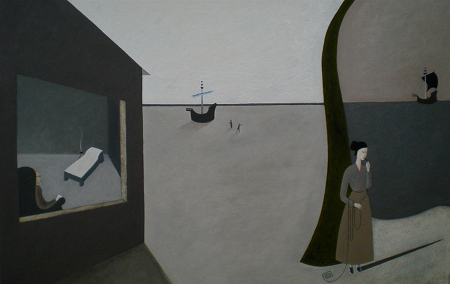|
|
| home | features | exhibitions | interviews | profiles | webprojects | gazetteer | links | archive | forum |
|
The Thin Hiss of Flowers Screaming Andrew Lanyon is an artist, author and film-maker. Paul Newman explores some of the ideas behind his exhibition and book 'Von Ribbentrop in St Ives: Art and War in the Last Resort'
Well-known in Cornwall, Andrew Lanyon’s talent combines the visual and verbal mediums, making books, paintings, mobile constructions, films, photographs and – just to drive home his blockheaded practicality – fairies’ wands. Lanyon is also supreme master of biting the hand that feeds, being the most zealous exponent of Anti-Art in the business. After all, his father, Peter Lanyon, had single-handedly redefined landscape painting in Cornwall, evolving a vocabulary of abstraction that others attempted to take forward. Hence there must have been sufficient paint and arty talk in his background for him to occasionally want to cut loose and burn a few canvases or sledgehammer a Michelangelo or Henry Moore.
What gripped Andrew Lanyon about this unappealing if not uninteresting Nazi is that he visited Cornwall in 1937 and was hospitably received by the Bolithos and other local dignitaries, simultaneously enjoying a fling with Bessie Wallis Simpson, the Duke of Windsor’s flighty wife. It is also thought that he prepared the way for German conquest by taking snapshots and buying postcards to be used for an invasion handbook. He had taken a liking to the duchy and entertained the idea that, after the triumph of the Third Reich, Hitler would hand Cornwall over to him and he would install himself on St Michael’s Mount as the Nazi pontiff. From this historical footnote, Andrew Lanyon has spun an entrancing web that incorporates many colourful elements. War and art, he maintains, are as far apart from each other as possible. Art constructs, war destructs, and wartime art immortalises the destruction. If the factual record of Ribbentrop’s intrigues occupies much of the printed text, equally important is the way in which the brewing hostilities modified the responses and techniques of local artists. Many other issues and points are raised, several only fleetingly, so it is helpful to outline the central preoccupations of this offbeat if also disquieting exhibition. There is the suggestion that because postcards and guidebooks contained data useful to the enemy – especially Luftwaffe pilots who bombed specific targets – the authorities were wary of painters who reproduced landmarks in a literal, accurate manner, preferring more abstract styles that blurred the subject matter and gave nothing away (although of course the latter were also suspected of encoding military secrets). Another aspect of this strategy was camouflage or disguise which also supplies an intriguing tension between the false and true; even familiar objects, like Cornish “stone hedges”, referred to in the enemy handbook as providing good cover for ground-fighting. A second preoccupation is how the sophisticated artist, Ben Nicholson, learned about art from the passionate primitive, Alfred Wallis. Lanyon sees Wallis’s emotionally charged paintings as deeply influencing the younger man, not only in terms of technique but also by the example of Wallis’s fervent, self-devouring application. Nicholson recognised the fool who persists in his folly really does become a wise man. Wallis taught him what you wanted to convey was more urgent that any rationalising process. Paint instinctually. Let your feelings seep through your brush rather than think it out. The third major issue concerns the imagination and how it is better to keep it in perpetual motion, shuffling images and impressions like decks of cards or bits of coloured glass in a kaleidoscope, rather than let it freeze into a fixity. Influentially if not convincingly, this deconstructionist argument places language in the dock and finds it guilty of atrocity. As the brutalising logic of rational thinking led to the death camps, it is far better to keep things flickering and flexible, frenetically and contrarily active, lest laws harden into stone tablets that punish the innocent. Unfortunately, on a diplomatic plain, such a hectic imagination would generate even more bedlam than the Nazis. It would be like government by the Keystone Cops, a disastrous rampage, but maybe the sheer hilarity would be worth it.
Allowing that the grim concept of war dominates, the effect is not what one might anticipate. Many war artists, including Paul Nash and Stanley Spencer, have laid on thickly the blood, barbed wire and guts, painting fire-torn skies, bodies on stretchers, rippling clouds of cordite and sliced-off buildings. So there is little point in Lanyon reselling such clichés (that are also, of course, shocking physical truths). Instead we are presented with a haunting detachment that stands apart from the ravages and violations and posits a visual hostility in terms of realism, abstraction and horizontal versus vertical. It is nothing about the war in one sense and it is nothing but war in another. The documentary exhibits are defiantly real, including original photos, galoshes used on the Eastern Front, guns, model tanks and Nazi insignia. Nor is the pain of combat, the plight of the tortured prisoner, overlooked, but deputised for in botanical guise by flower-heads with electrodes attached; the flower is screaming but who can unbind it without tearing off its petals? In addition, there is the appetising spectacle of a barbecued Giacometti and, more conventionally enticing, a painting of a biplane dropping fire bombs which exquisitely turn into a shower of roses for a local flower show and are also replicated by the red glow of a cigarette tip clamped in the lips of a soldier. It is as if War has been posted from the Territorial Army to the Exotic Metaphor Brigade. However, the imagery is apt, for Lanyon’s substitution of the peaceful for the violent – flowers instead of bombs – manages to bloodlessly anticipate the wreaths that will be laid on the graves of those warring parties. Whatever horrors are reciprocally inflicted, vegetation will heal it over, being unable to indulge the luxury of hatred. As for the atmosphere of Lanyon’s painting, they vary, some possessing a tense, brooding gloom and others a comical forlorn quality. Yet another category presents the fantastic with placid authority, vaguely recalling a Rupert the Bear adventure, a spell-like hush, a dreamland atmosphere that insinuates into one’s thoughts as much as one’s senses. The rich blues, the generally flat perspectives, the eschewing of naturalistic or muscular ligature for rounded, acquiescent, toy-town figures – all these achieve a documentary scarcity made appealing by the autumnal colours that echo the war era, fawns, greys, bark browns, secretive greens and shades of midnight blue. We are definitely there, in the fray, but over half a century later, with all the main players dead, should we revive old emotions of horror and pity or is it more relevant and restorative to see from the angle of a dance of ideas, a conceptual cartoon?
What is noticeable is that a good deal of the conditional tense filters into Lanyon’s adroit, well-phrased prose. He tries to persuade us things could so easily have been different, that this instead of that might have happened, but still he may have to work pretty hard to convert us to some of the alternative scenarios he postulates: “The idea that Ribbentrop might have sent Hitler a postcard from St Ives leads to the possibility that Churchill received one with ‘Wish you were here’ in the Fuhrer’s hand. It is not hard to imagine Hitler’s reaction on receiving a negative reply from Churchill, perhaps on an outsize card of the Tower of London, and to picture him folding this angrily into a paper aeroplane to launch it across his map of Europe. And then it is all too easy to imagine this paper dart turning into a real plane, whose mission initiates the to-and-fro, of a town for a town, a city for a city, the high note of a single plane dropping gradually to the low drone of a wave of bombers.” What is entertaining is “not hard to imagine” or “all too easy to imagine” applied to a preposterous, madcap farrago in blatant defiance of physical law. One might just about picture it brewing in the head of Andrew Lanyon or a crazed Czech cartoonist but never, never, in the mind of your average hominid. Nevertheless, in all seriousness or frivolousness, Von Ribbentrop in St Ives is an exciting, densely meditated and spectacularly agile blend of language, paint and argument.
Images top to bottom: Ribbentrop, Wallis and
Stokes: What U-Boat Commander in his right mind would steer their craft
using an Alfred Wallis?: Freud and Ariadne. All paintings on board by
Andrew Lanyon. |
|
|

 At
first glance the title of his intensely fertile and stimulating
exhibition and book is liable to evoke puzzlement. Von Ribbentrop? Who
on earth was he? Joachim Von Ribbentrop (1993-1946) was Hitler’s
ambassador to Britain until World War 2 and was executed at Nuremberg.
By no means well-liked, even the Nazi top brass derided him as a pompous
upstart – an ex-wine salesman who inveigled his way into Hitler’s inner
circle. Invariably he prostrated himself before the Fuhrer, obeying his
every whim and carving out a lavish lifestyle for himself and his even
more expensive wife.
At
first glance the title of his intensely fertile and stimulating
exhibition and book is liable to evoke puzzlement. Von Ribbentrop? Who
on earth was he? Joachim Von Ribbentrop (1993-1946) was Hitler’s
ambassador to Britain until World War 2 and was executed at Nuremberg.
By no means well-liked, even the Nazi top brass derided him as a pompous
upstart – an ex-wine salesman who inveigled his way into Hitler’s inner
circle. Invariably he prostrated himself before the Fuhrer, obeying his
every whim and carving out a lavish lifestyle for himself and his even
more expensive wife.  In addition to this clump of notions,
‘Resistentialism’ makes a guest appearance. This spoof philosophy – a
skit on ‘Existentialism’ – takes the viewpoint of the objects humans
manufacture and manipulate. What do they think of us? Obviously they are
against us – perhaps actively at war with us – and that is why, whenever
we drop a bit of toast, it falls butter-side down or tin-openers jag our
skin and banana skins wait around slyly to trip us. In Lanyon’s
case, we are privileged to share the viewpoint of a vase who will be
mutilated by various artistic fads and fashions, twisted out of shape or
reduced to a series of spotty impressions or Cubist sharp edges. Another
contender is a beaky camera who aggressively gobbles down coastal
snapshots from the fastness of a submarine.
In addition to this clump of notions,
‘Resistentialism’ makes a guest appearance. This spoof philosophy – a
skit on ‘Existentialism’ – takes the viewpoint of the objects humans
manufacture and manipulate. What do they think of us? Obviously they are
against us – perhaps actively at war with us – and that is why, whenever
we drop a bit of toast, it falls butter-side down or tin-openers jag our
skin and banana skins wait around slyly to trip us. In Lanyon’s
case, we are privileged to share the viewpoint of a vase who will be
mutilated by various artistic fads and fashions, twisted out of shape or
reduced to a series of spotty impressions or Cubist sharp edges. Another
contender is a beaky camera who aggressively gobbles down coastal
snapshots from the fastness of a submarine. Here
I speak only in terms of the images, for the text of Ribbentrop in St
Ives contains prescient pages dealing with things like the normalisation
of atrocity through language and a Stalinist condemnation of compassion
as being indicative of bourgeois humanism that, if allowed to take root,
would subvert the triumph of Communism. It is interesting to compare
Lanyon’s words with the images that back them. The latter are
tight-lipped, solemn and sparing of line while the language conveying
them to the page is excitable, vivid, exuberant and daring of metaphor
and analogy. It is as if the words want to run away with the show but it
is the impassive visuals that win this particular war. The language may
be brilliant but the paintings grab the eye with the speed of light.
Here
I speak only in terms of the images, for the text of Ribbentrop in St
Ives contains prescient pages dealing with things like the normalisation
of atrocity through language and a Stalinist condemnation of compassion
as being indicative of bourgeois humanism that, if allowed to take root,
would subvert the triumph of Communism. It is interesting to compare
Lanyon’s words with the images that back them. The latter are
tight-lipped, solemn and sparing of line while the language conveying
them to the page is excitable, vivid, exuberant and daring of metaphor
and analogy. It is as if the words want to run away with the show but it
is the impassive visuals that win this particular war. The language may
be brilliant but the paintings grab the eye with the speed of light.